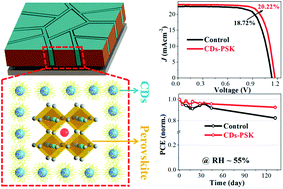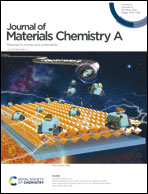Self-assembled carbon dot-wrapped perovskites enable light trapping and defect passivation for efficient and stable perovskite solar cells†
Abstract
Simultaneously improving photovoltaic performance and longevity has become the main focus towards the commercialization of metal halide perovskite solar technology. Herein, we demonstrate resilient, high-efficiency triple-cation perovskite solar cells (PSCs) by incorporating carbon dots (CDs) derived from human hair into the perovskite film synthesis. It is found that a toluene-based antisolvent containing CDs results in the formation of a bilayer structure where a wave-like textured top perovskite layer is assembled on the bottom dense perovskite counterpart, enabling reduced optical losses through light trapping. Further characterization has revealed that the CDs are formed around and over the surface of perovskite crystals, serving as a full armour to preserve the perovskite stoichiometry during the crystallization and operation. Accordingly, the CD-wrapped perovskite film demonstrates a reduced density of interfacial defects including metallic lead clusters and uncoordinated halide vacancies, improved carrier recombination lifetime, better energy alignment with the adjacent hole transport layer, and enhanced hydrophobicity. By leveraging these advantages to enhance the efficiency of PSCs, we have achieved a maximum power conversion efficiency of 20.22%, higher than 18.72% for PSCs without CDs, and the device stability is also significantly enhanced.



 Please wait while we load your content...
Please wait while we load your content...